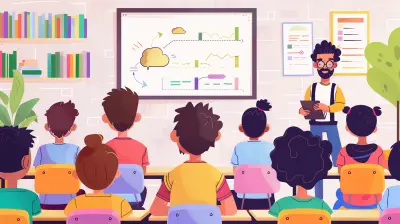14 February 2025
In the world of e-learning, engagement can often be a challenge. We've all sat through those dry, monotonous presentations that feel more like a chore than an exciting opportunity to learn something new. But what if I told you there’s a secret sauce that can transform your e-learning courses from dull to dynamic? Yep, it’s storytelling.
Storytelling has this incredible power to captivate, inspire, and teach. It’s been around since the dawn of humanity—cave paintings, myths, legends, and bedtime tales have all been ways to share wisdom and lessons. But what does that have to do with e-learning? Well, quite a lot actually. In this article, we’ll dive deep into how you can use storytelling to make your e-learning courses not just more informative, but more engaging and impactful.

Why Storytelling Works
Before we get into the nitty-gritty of how to incorporate storytelling into e-learning, let’s first explore why it works so well.1. Stories Tap Into Emotions
We, as humans, are emotional creatures. Think about the last time you watched a great movie or read a compelling book. How did you feel? Stories evoke emotions—happiness, sadness, excitement, surprise—and these emotions help us remember things better. When learners are emotionally connected to the material, they’re more likely to retain information.2. They Make Abstract Concepts Concrete
Let’s face it, some e-learning topics can be abstract and hard to grasp. Storytelling can bridge this gap by making complex ideas more relatable. For example, if you’re teaching a technical topic like data security, telling a story about a company that faced a data breach can make the subject feel real and understandable. Suddenly, it’s not just about numbers and protocols; it’s about real-world consequences.3. Stories Stick
Ever heard of the "forgetting curve"? Research shows that people forget about 50% of new information within an hour and up to 90% within a week. Stories, however, are much harder to forget. They create mental hooks that learners can recall much later. A well-crafted story can make your lesson far more memorable.4. They Encourage Participation
Stories naturally invite curiosity. When learners are engrossed in a story, they’re more likely to engage, participate, and ask questions. It’s the difference between passively reading a textbook and actively trying to guess how a story will end. When learners are engaged, they’re much more likely to invest their attention and energy into the course.
How to Use Storytelling to Make E-Learning More Engaging
Now that we know why storytelling is so powerful, let’s get into the how. Below are practical steps and tips for weaving storytelling into your e-learning courses.1. Start with a Hook
Just like in any good book or movie, the beginning is crucial. You need to grab your learners’ attention right from the get-go. Starting with a hook—a compelling question, a surprising fact, or an emotional scenario—can make all the difference.For example, if you’re teaching a course on leadership, you could start with:
"Imagine you're the captain of a sinking ship. How would you lead your crew to safety?"
This immediately places the learner in a situation where they have an emotional stake and are eager to find out what happens next.
Tip:
Start with something relatable. Your learners should be able to place themselves in the story right from the start.2. Introduce Characters
Every good story needs characters. In e-learning, your characters don’t have to be fully fleshed-out personas like in a novel, but they should be relatable figures your learners can connect with. Characters can be fictional or based on real people, but they should serve a purpose in driving your lesson home.For instance, if you’re teaching a course on customer service, you might introduce "Sarah," a customer service rep who’s navigating a tough situation with an irate customer. Learners can follow Sarah’s journey, learning through her actions and decisions.
Tip:
You don’t need a huge cast of characters. One or two well-chosen characters can be enough to carry the story and keep things simple.3. Use Conflict and Resolution
Conflict is the heartbeat of any good story. Without tension or challenges, stories become boring. In the context of e-learning, conflict doesn’t have to mean a dramatic showdown. It could be a problem that needs solving or a challenge that the character faces.For example, if you’re teaching project management, your conflict could revolve around a project falling behind schedule. How will the project manager handle it? The resolution comes when the character overcomes the challenge, providing a learning opportunity for your students.
Tip:
When introducing conflict, make sure the resolution ties directly into the lesson you’re teaching. This is where the real learning happens.4. Incorporate Dialogue
One of the most overlooked aspects of storytelling in e-learning is dialogue. Dialogue can breathe life into your characters and make the narrative feel more dynamic. It’s also a great way to present multiple perspectives or ideas without overwhelming the learner with too much information at once.If you’re teaching negotiation skills, you could create a dialogue between two people negotiating a contract. This allows learners to see how the back-and-forth conversation plays out in real time, making the lesson more interactive.
Tip:
Keep the dialogue realistic and concise. You don’t want to bog down your learners with long, drawn-out conversations.5. Create a Narrative Arc
Every good story follows a narrative arc—introduction, rising action, climax, falling action, and resolution. Your e-learning course should follow a similar structure. Think about your lessons in terms of a journey. You’re guiding your learners from point A to point B, with challenges and revelations along the way.For example, if you’re teaching a course on time management, start by introducing the problem (e.g., "John is struggling to balance his work and personal life"). Then, build the rising action (e.g., "John tries different techniques to manage his time but keeps failing"). Finally, reach the climax and resolution (e.g., "John discovers the time-blocking method and dramatically improves his productivity").
Tip:
Don’t rush the story. Give your learners time to absorb the information and progress through the narrative.6. Use Visuals to Support the Story
A picture is worth a thousand words, right? Visuals can play a huge role in storytelling, especially in e-learning. Images, videos, and infographics can help reinforce key points in your story. For example, if your story involves a character navigating a complex system, a flowchart or diagram can help map out the process.Tip:
Make sure your visuals enhance the story rather than distract from it. They should complement the narrative, not compete with it.7. Make the Learner the Hero
One of the most powerful ways to use storytelling in e-learning is to make your learner the hero of the story. Instead of having them passively watch characters navigate situations, put them in the driver’s seat. This can be done through interactive scenarios where learners make choices that affect the outcome of the story.For example, in a course on decision-making, present learners with a scenario where they have to make tough choices under pressure. Their decisions will then determine how the story unfolds, making the experience more immersive and engaging.
Tip:
Provide feedback based on the learner’s decisions, helping them see the consequences of their actions and what they could have done better.8. Add a Personal Touch
Remember, stories are meant to be personal and relatable. Don’t be afraid to add a touch of humanity to your e-learning. Share personal anecdotes, real-life case studies, or relatable scenarios that your learners might face in their own lives. This builds a connection and makes the learning experience feel more authentic.Tip:
Keep it conversational. You don’t want your e-learning course to feel like a lecture. Talk to your learners as though you’re having a one-on-one conversation.
The Benefits of Storytelling in E-Learning
By now, you probably have a good sense of how storytelling can enhance your e-learning courses. But let’s quickly recap the key benefits:- Improves Engagement: Stories capture attention and keep learners hooked.
- Boosts Retention: Learners are more likely to remember stories than dry facts.
- Simplifies Complex Concepts: Storytelling makes difficult topics easier to understand.
- Encourages Participation: Stories invite learners to think, question, and participate.
- Creates a Memorable Experience: A great story can turn an ordinary course into an unforgettable learning experience.

Conclusion
Storytelling isn’t just a fun addition to e-learning—it’s a powerful tool that can transform how learners absorb, engage with, and retain information. By starting with a strong hook, introducing relatable characters, incorporating conflict and resolution, and making your learner the hero of the story, you can elevate your e-learning courses from good to great.So, the next time you’re designing an e-learning course, think about how you can weave a story into the content. Whether it’s a simple anecdote or a full-blown narrative arc, storytelling can make your material not just informative, but engaging and memorable.












Kristina Johnson
Engaging stories transform e-learning into memorable experiences!
April 7, 2025 at 6:29 PM